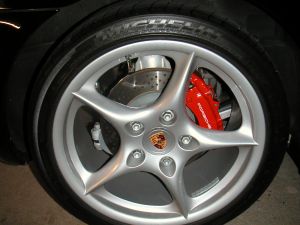AtAAMCO Colorado, we want all drivers to get where they need to be safely. This means that your brakes need to be functioning properly, and ready to stop when needed. Brake maintenance, therefore, is necessary and is something that is often neglected. If you are looking to have your vehicle’s brakes serviced, visit one of the many Colorado AAMCO locations where our experienced and knowledgeable staff can help keep your vehicle in proper driving condition.

How Does A Vehicles Brake System Work?
Very few parts to a vehicle work independently from one another, and the brake system is no exception. Your brakes rely on each part and piece to function properly and safely. Your brakes have but a single goal to achieve, which is to safely and precisely stop the motion of a vehicle. If the brakes didn’t do this, they wouldn’t exactly be brakes.
The brake system works when the driver presses on the brake pedal. This activates the cylinder that sends the brake fluid to the calipers which engage the brake pads. The brakes pads are what applies pressure to the rotors, which create the friction required to slow down and stop a vehicle. If any of these parts fail, the whole system is compromised.
What Are Brake Pads?
A vehicle’s brake pads are what makes contact with the rotor to create friction to slow down a vehicle. They essentially do the heavy lifting of all the brake parts. Over time, pads wear down due to the friction and need to be replaced. Almost the same as an eraser on a pencil, the more friction it is exposed to, the more worn down it becomes.
What Is A Rotor?
The rotor is the disc the brake pads latch onto when the brakes are applied to slow down. The rotor is directly connected to each tire, and in order to stop your car entirely, the rotor must stop rotating.
What Is A Caliper?
A vehicle’s calipers require brake fluid to work properly. The caliper applies pressure which activates the brake pads and forces them to make contact with the rotors.
What Is A Brake Hose?
The brake hose is attached to each caliper, and when you press on the brake pedal, this forces the fluid to push the brake pads down into the rotor, which is what slows down the vehicle.
What Does Brake Fluid Do?
As described a little above, brake fluid is the element that runs through the brake hose. When the brake pedal is applied, it generates pressure which pushes the pads into the rotor thus slowing your vehicle. If you have a brake leak, you will notice it becoming increasingly difficult to slow down, and more force must be applied to the brake pedal in order to stop it. If you notice this in your vehicle, you ought to immediately find a brake mechanic to check it out as driving with brake fluid leaking is terribly dangerous.
What Constitutes A Brake Inspection?
At AAMCO Colorado, you can trust that the brake service we offer is thorough, detailed, and methodical. We strive to ensure every vehicle we service is safe for driving, and that you feel safe driving it.
Brake Inspection includes:
- Replacing worn pads and shoes.
- Wheel bearings repacked as needed.
- Lubrication for specified components.
- Rotor and drum resurfacing (may need replacement if wear is excessive).
- Replacement of other components based on findings of the inspection.
- Old brake fluid is replaced with fresh fluid.
- Adjusting the parking brake.
- Road test to ensure the entire braking system is operating properly.
How Often Should You Have Your Brakes Checked?
It is recommended that you have your brakes inspected at least once a year. A yearly check-up will not only ensure your safety when you are on the road, but it can also help discover minor problems that can be corrected, rather than waiting for it to break and have to be replaced. Consulting your owner’s manual is also a good way to know how often your brakes should be checked on because, for certain sports models, the brakes need to be checked much more frequently.
